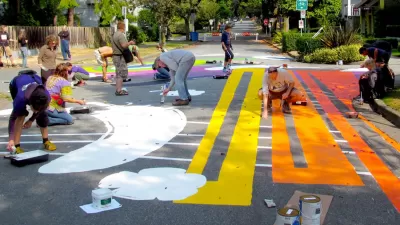Kelly Morphy provides tips and strategies on improving civic engagement - the key to healthy communities and desired outcomes.
While from a professional perspective, there is increasing concurrence among planners as to the importance of mixed uses, green space, compact urban form, and the pedestrian scale, Morphy argues we still have a gap to close in getting the communities in which we work on board with these concepts. Crucial to closing this gap is engaging in effective community outreach.
Aside from the imperative that "community members should be co-authors of their future," Morphy adds that planners should be proactive in their communities because involvement "improves chances of a project or program succeeding," "leads to better community health," and "builds social capital." She follows with sugested strategies for crafting a sincere, open, and effective engagement process.
The fundamental component in growing healthier communities is to build relationships, writes Morphy. Planners should be proactive in arranging meetings, come prepared to listen, and follow up with "a sincere response focused on acknowledgement and validation." They also should be comfortable in ceding control to "put the community's future in the community's hands." Even more important, states Morphy, is to begin any successful community-engagement program by identifying the desired outcomes, and developing a plan to achieve them.
"We can stand to be a bit more creative about the way we engage our communities," remarks Morphy, "...But true community engagement takes time, takes relationship-building, and requires you to build trust with the community."
FULL STORY: Want better communities? Engage them better!

Planetizen Federal Action Tracker
A weekly monitor of how Trump’s orders and actions are impacting planners and planning in America.

Maui's Vacation Rental Debate Turns Ugly
Verbal attacks, misinformation campaigns and fistfights plague a high-stakes debate to convert thousands of vacation rentals into long-term housing.

San Francisco Suspends Traffic Calming Amidst Record Deaths
Citing “a challenging fiscal landscape,” the city will cease the program on the heels of 42 traffic deaths, including 24 pedestrians.

Defunct Pittsburgh Power Plant to Become Residential Tower
A decommissioned steam heat plant will be redeveloped into almost 100 affordable housing units.

Trump Prompts Restructuring of Transportation Research Board in “Unprecedented Overreach”
The TRB has eliminated more than half of its committees including those focused on climate, equity, and cities.

Amtrak Rolls Out New Orleans to Alabama “Mardi Gras” Train
The new service will operate morning and evening departures between Mobile and New Orleans.
Urban Design for Planners 1: Software Tools
This six-course series explores essential urban design concepts using open source software and equips planners with the tools they need to participate fully in the urban design process.
Planning for Universal Design
Learn the tools for implementing Universal Design in planning regulations.
Heyer Gruel & Associates PA
JM Goldson LLC
Custer County Colorado
City of Camden Redevelopment Agency
City of Astoria
Transportation Research & Education Center (TREC) at Portland State University
Jefferson Parish Government
Camden Redevelopment Agency
City of Claremont





























